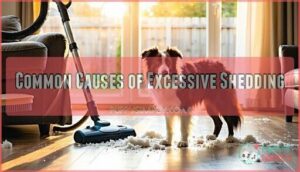This site is supported by our readers. We may earn a commission, at no cost to you, if you purchase through links.

These clever herding dogs come equipped with a double coat designed to protect them through Scottish highlands weather, which means they drop hair year-round with striking seasonal "blow-outs" twice a year.
The good news? Understanding why they shed and how to manage it can save your sanity (and your vacuum cleaner). Most of what triggers excessive shedding is actually within your control, from diet tweaks to brushing techniques that make a real difference.
Table Of Contents
- Key Takeaways
- Do Border Collies Shed a Lot?
- What Makes Border Collie Coats Unique?
- When and How Much Do Border Collies Shed?
- Shedding in Border Collie Puppies
- Common Causes of Excessive Shedding
- How to Reduce Border Collie Shedding
- Best Home Strategies for Managing Fur
- Frequently Asked Questions (FAQs)
- Conclusion
Key Takeaways
- Border Collies shed year-round with two intense seasonal "blowouts" in spring and fall when their double coat releases massive amounts of undercoat, making them moderate-to-heavy shedders comparable to Golden Retrievers and German Shepherds.
- Regular brushing with the right tools (undercoat rake followed by slicker brush) combined with a diet rich in omega-3 fatty acids can significantly reduce shedding by removing loose fur and strengthening skin health from the inside out.
- Excessive shedding beyond normal patterns often signals underlying problems like allergies (affecting nearly 3% of Border Collies), poor nutrition, stress, or overbathing that strips essential oils from their skin.
- Climate and indoor environment directly impact shedding patterns—dogs in consistently warm climates shed more evenly year-round while those in seasonal climates experience dramatic coat changes, and indoor heating or cooling can confuse natural shedding cycles.
Do Border Collies Shed a Lot?
Yes, Border Collies shed quite a bit—some would say they’re pros at it. The amount and timing depend on several factors, from their unique coat structure to the season and even where you live.
Let’s break down what you can actually expect regarding shedding frequency, the reasons behind it, and how Border Collies stack up against other breeds.
Shedding Frequency and Intensity
If you’re expecting a low-maintenance coat, I’ll be straight with you—Border Collies shed consistently throughout the year, with two intense "blowout" periods in spring and fall when you’ll find tumbleweeds of fur in every corner of your home.
Border Collies shed year-round with two explosive seasonal blowouts that turn your home into a fur factory
Their coat density drives this shedding frequency, and individual variation means some dogs shed more heavily than others. During peak shedding season, you’re looking at daily brushing to stay ahead of the hair.
Why Border Collies Shed
Understanding what’s happening beneath all that fur helps you manage it—Border Collies shed because their natural coat cycle constantly moves through growth, rest, and release phases, with the soft undercoat doing most of the heavy lifting in terms of leaving hair on your couch.
This double coat also helps with temperature regulation, keeping them cool in summer and warm in winter.
Their breed energy and working heritage mean they’ve developed these shedding habits as a natural process—it’s basically their body’s way of adapting to seasonal changes and maintaining a healthy coat year-round.
Shedding Compared to Other Breeds
Border Collies land in the moderate-to-heavy shedding category, right alongside breeds like Golden Retrievers and German Shepherds—all dog breeds with thick coats that need regular maintenance. You won’t find them on any hypoallergenic breeds list, but they’re not the absolute worst offenders either. Compared to heavy shedders like Huskies, Border Collies shed less overall, though their grooming time commitment and maintenance cost analysis still matter.
Different dog breeds’ shedding habits depend on breed shedding factors like coat type and lifestyle, so knowing your dog breed information helps set realistic expectations. They possess a thick double coat that contributes to their shedding habits.
What Makes Border Collie Coats Unique?
Border Collies don’t just shed—they do it with purpose, thanks to a coat that’s built like a two-layer survival system. Understanding what makes their fur different helps you manage it better.
Let’s break down the key features that set Border Collie coats apart.
Double Coat Structure Explained
Think of your Border Collie’s coat like a well-designed winter jacket—there’s an outer shell that keeps the rain and wind at bay, and a fluffy insulation layer underneath that traps warmth close to the body. The undercoat is soft and dense, providing natural insulation your dog needs. The guard coat sits on top, protecting against dirt and moisture.
This double coat evolved because Border Collies were bred to herd livestock in harsh Scottish weather.
Smooth Vs. Rough Coat Types
You might’ve noticed that Border Collies don’t all look the same—some have long, flowing fur that makes them look like they’re ready for a shampoo commercial, while others sport a sleeker, shorter coat that’s all business. These are the two official coat types: rough and smooth.
Here’s the twist—both shed the exact same amount. The rough coat just makes shedding more visible because longer hairs are easier to spot on your couch. Maintenance effort differs slightly, but grooming differences won’t change your vacuum schedule.
Coat Color and Shedding Myths
Here’s the scoop: coat color has nothing to do with how much your Border Collie sheds. Whether you’ve got a classic black-and-white, a striking red merle, or a tri-color beauty, they all shed the same amount—that’s the veterinary consensus based on genetics and real-world observations.
- Darker coats don’t shed more—that myth likely comes from dark fur showing up better on light furniture, not actual shedding volume
- Coat color genetics (the genes controlling pigmentation) are completely separate from the genes that regulate shedding in Border Collies
- Owner perceptions often mistake visibility for quantity—white fur blends into carpets while black fur screams "vacuum me now!"
Understanding Border Collie coats means recognizing that coat type matters, but color affects shedding about as much as your dog’s name does. Border Collies possess a thick, double-layered coat that contributes to year-round shedding.
When and How Much Do Border Collies Shed?
Border Collies shed consistently throughout the year, but twice annually they go through intense shedding periods that can feel overwhelming. Understanding when to expect these changes helps you prepare with the right tools and routines.
Let’s break down what’s happening with your dog’s coat during different times of the year.
Year-Round Vs. Seasonal Shedding
Most dog owners assume their Border Collie sheds at the same steady pace all year long, but that’s only part of the story. Border Collies shed year-round in small amounts, but seasonal changes kick shedding into high gear. Spring and fall trigger heavy coat blow cycles as temperature shifts tell their bodies to swap out insulation.
Seasonal triggers don’t follow a calendar—they respond to your local climate. That’s why Border Collies in Florida might shed differently than those in Montana.
| Shedding Patterns | What to Expect |
|---|---|
| Year-Round | Light to moderate daily shedding |
| Spring (March–May) | Heavy coat blow as temperatures rise |
| Fall (September–November) | Intense seasonal shedding preparing for winter coat |
| Regional Variations | Warmer climates may trigger more frequent shedding cycles |
The “Blowing Coat” Phenomenon
When your Border Collie’s undercoat starts flying off in clumps that could stuff a small pillow, you’re witnessing what groomers call "blowing coat"—and it’s completely normal. This seasonal shedding explosion happens twice a year as your dog swaps their old undercoat for fresh insulation. Here’s what drives a coat blowout:
- Daylight hours trigger hormonal shifts that release the undercoat
- Temperature swings signal your dog’s body to prep for seasonal changes
- Humidity levels affect how quickly dead fur loosens and falls
- Indoor heating or cooling can extend or confuse natural shedding cycles
Expect two to three weeks of tumbleweeds rolling across your floors during peak coat blow timing.
Climate and Environmental Effects
Where you live plays a bigger role in your Border Collie’s shedding than you might think. Dogs in sunny California often shed more consistently year-round than their Montana cousins, who experience dramatic seasonal coat changes. Indoor heating dries out skin and triggers extra shedding during winter, while humidity levels affect how much dead fur clings to the undercoat before releasing.
| Environmental Factor | Impact on Shedding | What You’ll Notice |
|---|---|---|
| Seasonal Changes | Triggers coat blowouts twice yearly | Heavier spring/fall shedding cycles |
| Humidity Levels | High humidity loosens undercoat faster | More clumps during damp weather |
| Sun Exposure | Increases vitamin D, affects coat health | Year-round moderate shedding |
| Air Quality | Poor air irritates skin | Flakiness and increased hair loss |
| Altitude Effects | Thinner air = drier skin | More consistent shedding patterns |
Shedding in Border Collie Puppies
Border Collie puppies don’t shed much at first, but that changes as they grow. They’ll go through a coat shift that brings more fur than you might expect.
Here’s what you need to know about puppy shedding and how to manage it.
Puppy to Adult Coat Transition
Around three to four months old, your Border Collie puppy starts trading in that soft, fluffy baby coat for something more grown-up—and that’s when you’ll notice the real shedding kicks in. That wispy baby fluff gradually gives way to a thicker, denser adult coat over several months.
The texture changes dramatically—what felt like cotton candy becomes coarser and more weather-resistant as breed-specific differences emerge in your pup’s adult coat development.
When Puppies Start Shedding
You might catch the first signs of puppy shedding as early as eight weeks old, though it’s usually light and barely noticeable until that big coat changeover begins.
Most Border Collie puppy shedding becomes obvious between three and seven months, right when that initial shedding age overlaps with seasonal changes.
Breed-specific timelines vary, but expect loose fluff to really pick up during spring and fall when seasonal puppy shedding hits hardest.
Managing Puppy Shedding
Once that fluffy phase kicks in, a few simple grooming habits can keep your home—and your sanity—intact. Start brushing your puppy’s coat two to three times weekly using a slicker brush to catch loose fur before it spreads.
Keep dietary needs in check with quality puppy food rich in omega fatty acids—healthy skin means less shedding during coat changes and aids overall puppy development.
Common Causes of Excessive Shedding
Some shedding is normal, but if your Border Collie seems to be leaving behind more fur than usual, something else might be going on.
Excessive shedding can point to health problems, lifestyle factors, or grooming mistakes that are easy to overlook.
Let’s walk through the most common culprits so you know what to watch for.
Health Issues and Allergies
Allergies and skin issues can turn shedding from manageable to overwhelming. Around 2.66% of Border Collies develop hypersensitivity skin disorders, with food allergies affecting nearly 1% and flea allergic dermatitis appearing in others.
These allergy symptoms often show up as chronic itching, dermatitis, or even ear infections—conditions that irritate the skin and trigger excessive hair loss. If you’re noticing bald patches, constant scratching, or unusual shedding alongside redness or hives, your dog’s coat troubles might signal deeper skin health problems needing veterinary attention.
Stress, Diet, and Hormonal Changes
Beyond skin conditions, stress, poor nutrition, and hormonal imbalances can dramatically increase shedding. Low-quality diets lacking omega-3s, zinc, or protein may cause 25% more hair loss compared to nutrient-rich food.
Chronic stress from separation anxiety or loud noises triggers sudden shedding—sometimes over 200 strands in one episode. Hypothyroidism and Cushing’s disease also disrupt coat health, causing symmetrical bald patches alongside other symptoms like excessive thirst.
Overbathing and Skin Dryness
Washing your Border Collie too often—say, weekly instead of every 6 weeks—strips natural oils that keep their skin hydrated and their coat glossy. The result? Dry, flaky skin that triggers more shedding and constant itching.
Here’s how overbathing backfires:
- Bathing frequency matters—stick to 4-6 week intervals unless they’re filthy
- Use moisturizing dog shampoo designed for sensitive skin, not human products
- Rinse thoroughly to prevent skin irritation from leftover soap residue
- Follow up with conditioner to restore coat oils and lock in skin hydration
How to Reduce Border Collie Shedding
You can’t stop shedding completely, but you can make a real difference with the right approach. Most solutions are simple and fit into your routine without much hassle.
Let’s break down three key strategies that actually work.
Upgrading Diet and Supplements
What you feed your Border Collie doesn’t just fuel their energy—it directly affects how much fur ends up on your couch. A healthy diet rich in omega-3 fatty acids and essential nutrients strengthens skin and coat from the inside out. Look for high-quality protein sources and balanced nutrition in their dog food. Coat-specific supplements like fish oil can work wonders too.
Don’t forget hydration—proper water intake keeps skin elastic and reduces shedding.
Bathing and Anti-Shed Shampoos
When bath time rolls around—usually every six weeks—using an anti-shed shampoo can loosen those stubborn clumps of undercoat before they take over your home. Look for shampoos with ingredients like omega-3 or oatmeal that support skin care without drying. Follow up with a conditioner to keep the coat smooth.
Avoid overbathing, though—it strips natural oils and worsens shedding. If dog grooming feels overwhelming, professional grooming every few months helps.
Brushing Tools and Techniques
The right brush isn’t just helpful—it’s the difference between managing shedding and watching tumbleweeds of fur roll across your floor.
For a rough coat, start with an undercoat rake to pull loose fur from deep within, then follow with a slicker brush to smooth the top layer. Smooth coat Border Collies need the same tools but respond faster to brushing sessions.
Best Home Strategies for Managing Fur
Even with regular grooming, you’ll still find Border Collie fur around your home. The good news is that a few smart strategies can help you stay ahead of the mess without spending hours cleaning.
Here’s how to keep your space manageable when you share it with a heavy shedder.
Cleaning and Vacuuming Tips
Living with a Border Collie means accepting that fur becomes part of your home décor—but the right cleaning routine can help you stay ahead of the flurry. Invest in a vacuum with HEPA filters designed for pet hair removal, or let a robot vacuum take care of daily maintenance.
Air purifiers reduce airborne dander, while lint rollers tackle furniture and car seats. Washable furniture covers make cleanup simple between deep cleans.
Pet Hair Removal Tools
Your vacuum can only do so much—specialized tools tackle stubborn fur in places your Dyson can’t reach. Grooming gloves lift hair from upholstery while you pet. Lint rollers take care of quick furniture and clothing touch-ups between deep cleans.
Fabric shavers remove embedded fur from blankets and couch cushions. For hard-to-reach spots, brush attachments on your dog vacuum cleaner work wonders on stairs and baseboards.
Furniture and Clothing Solutions
Even with all the right tools, fur still finds its way onto everything you sit on, wear, or cuddle up with. Smart fabric choices and strategic furniture covers make home management of fur less maddening.
- Slipcovers and furniture covers trap hair and toss easily into the wash
- Designated dog beds keep shedding concentrated in one spot instead of your couch
- Lint rollers by the doorknob quick clothing fixes before you leave
Frequently Asked Questions (FAQs)
Do Border Collies shed more during specific times of the day?
No, shedding doesn’t follow a daily schedule tied to circadian rhythms or specific hours. Activity levels and light exposure matter more during seasonal changes.
Temperature shifts throughout the day might slightly increase loose fur, but Border Collie shedding habits primarily respond to seasonal changes, not time-of-day patterns.
Are Border Collies hypoallergenic or allergy-friendly?
Unfortunately, Border Collies aren’t hypoallergenic. They produce significant pet dander and shed heavily, which spreads allergen levels throughout your home.
Allergy sufferers often experience reactions due to dander production, not just the fur itself.
Breed misconceptions suggest some dogs are allergy-friendly, but cross-reactivity with proteins in saliva and skin cells remains problematic for most people with pet allergies.
Does spaying or neutering affect shedding patterns?
Hormonal changes after spaying or neutering can temporarily affect shedding patterns, though coat density generally returns to normal. Hair follicles respond to fluctuating hormone levels during the adjustment period, sometimes increasing seasonal shedding.
Can you trim a Border Collies coat?
You can trim a Border Collie’s coat, but avoid cutting too short—it damages their natural insulation. Light trimming for hygiene is fine, though many owners prefer professional grooming to maintain show standards and prevent coat damage from improper techniques.
Do Border Collies shed more than Labs?
Labs might just beat Border Collies at the shedding Olympics—both are moderate to heavy shedders with double coats, but Labrador coat density and activity level influence often edge them ahead in the fur department.
How long does the blowing coat phase last?
Blowing coat usually lasts two to four weeks, though individual variation and environmental factors affect the shedding cycle. Management impact through brushing can shorten this seasonal shedding phase, while coat regrowth begins as the coat blowout ends.
Conclusion
Your vacuum cleaner has officially declared war on your Border Collie’s undercoat, and honestly, it’s losing. Border Collies shed—enthusiastically, relentlessly, and with zero remorse. But here’s the truth: you can’t stop it, only manage it.
The right brush, a solid diet, and consistent grooming routines transform chaos into something tolerable. Your couch might never be fur-free, but armed with the facts about why and when these dogs shed, you’re no longer fighting blind.
Accept the fluff, master the tools, and reclaim your home.














